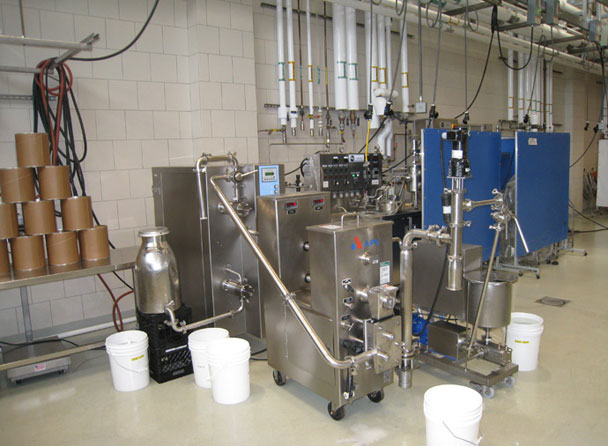Want the scoop on the coolest job? Robert Roberts, Ph.D., associate professor of food science, is Penn State’s resident authority on ice cream: He’s the director of the university’s annual weeklong Ice Cream Short Course. Dating back to 1892, the program is the oldest and best known of its type in the United States. Dr. Roberts, director since 1999, has the tasty task of leading the course into its second century. He took the time to school us in what the course covers, how it has evolved over the past 119 years, and where he believes the ice cream business is headed.
Gourmet Live: When people hear that you are the director of an ice cream school, what do they say?
Robert Roberts: There are two typical reactions. One is, “That must be cool,” and the other is, “There’s really enough to learn about ice cream that you can take seven days to teach it?” And the answer is, yes, it is cool—in a punny way and in reality. It’s a lot of fun. And, oh, yes, absolutely, there is enough to learn that it takes at least seven days, and that just cracks the surface.
GL: How has the mission of the Ice Cream Short Course changed since its founding as a resource for Pennsylvania’s dairy farmers and pioneering ice cream makers?
RR: One of my colleagues, former director Phil Keeney, tells me that when he started doing the Ice Cream Short Course, in the 1950s, there were more ice cream manufacturers in Pennsylvania than there are in the U.S. today. So at that time they were teaching the basics of the manufacture of ice cream—how do you compound a mix, how do you process a mix, what’s the function of different ingredients—with the expectation that everybody was going to be doing everything. Now, it’s very similar, but the expectation isn’t that everybody is going to be doing everything. We cover more of the science, technology, and physical chemistry now, because as the industry has both grown and consolidated, small problems have become larger, because you are distributing the ice cream over longer distances and you have many more people involved in handling the product.
GL: Who is the typical student for the program?
RR: The Ice Cream Short Course is aimed at the industrial manufacturer of ice cream and is also for anybody who wants to get into the nitty–gritty of how ice cream is put together. The class will be made up of manufacturers, people in the ice cream industry (they may work in processing, freezing, new–product development, quality assurance), but they’ll be taking the course to really understand their product. I’d say somewhere between a third and a quarter of the students will be entrepreneurs who are thinking seriously about making their own ice cream mix and really want to know what that entails. And we have a lot of ingredient suppliers. Then we get—and I mean this with all affection—ice cream junkies. We get people who just want to come in and learn everything they can about ice cream, just for fun. Routinely, we get doctors and lawyers who are in the class on vacation. They’ll say that they’re thinking about it as a second career and they’re looking for something that is happy. And people who are in ice cream are happy.
GL: What’s the geographic makeup of your student body?
RR: We make a sweatshirt every year, and on the back it will have the names of the states and countries, and it’s usually about 25 or 30 states and about seven countries. We get Mexico, Canada; we have had Russia, Australia, New Zealand, Argentina, Venezuela, India, France. When you look at a map of the United States, we can verify that someone has attended the Ice Cream Short Course from every state—except North Dakota. So, we haven’t figured out what’s going on in North Dakota, but we really want to finish the map, so if somebody wants to contact me, we can talk.
GL: How does the newer Ice Cream 101 program you introduced differ from the Short Course?
RR: Ice Cream 101 is designed for entrepreneurs—the mom–and–pop operator. It’s a two–day course, run over a weekend. It’s not the same level of detail—not nearly the same level of science. It is designed for folks who want to open an ice cream shop in the more traditional way, and by that I mean that rather than making your ice cream mix, you purchase a mix that has been manufactured by a dairy and then you flavor that. When you make your own mix, you fall under another set of rules: You have to get a pasteurizer, you have to do a number of things that don’t have to happen if you buy the mix in a bag. There are lots of really good mixes out there for use by shops, so we talk about how you make an ice cream mix, but we also have somebody come in and talk about how you choose an ice cream mix supplier.
GL: What percentage of students, would you say, enjoys the experience but decides to stick with their day job?
RR: I don’t have good numbers on that, but I would say probably 50 percent, at least. People are thinking about getting into the business, but they don’t realize that it is a business. Let me put it this way: If you are going to have an ice cream shop and prepare fresh ice cream on a regular basis, you are going to be open from, let’s say, 10 in the morning until 9 or 10 at night. Somebody is going to have to make the ice cream. Your cash flow is going to be such that you’re probably going to be making the ice cream.



 Pinterest
Pinterest


